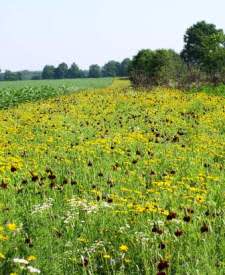President Obama Delivers New Habitat Tools for Pheasants, Quail
Pheasants Forever 03.04.12

Washington, DC – Pheasants Forever & Quail Forever received welcome news about the Conservation Reserve Program (CRP) from Agriculture Secretary Tom Vilsack today. During the White House’s Conference on Conservation at the Department of Interior Building, the Secretary will announce the reallocation of one million CRP acres to the most popular continuous practices within the program. The President will also announce a significant increase for signing incentive payments from $100 per acre to $150 per acre to encourage landowner participation in CRP.
“No matter how staggeringly impressive the wildlife, water quality, flood mitigation and soil benefits of CRP are to society, the program needs to make sense to a farmer’s bottom line in order for CRP to succeed. Today, Secretary Vilsack and President Obama sent a clear signal that CRP is evolving into a more focused, strategic and financially competitive conservation option for farmers and ranchers. There is no doubt commodities are out-competing yesterday’s CRP, but it’s also clear these focused CRP practices are an asset to any farmer and rancher’s balance sheet,” observed Dave Nomsen, Pheasants Forever & Quail Forever’s Vice President of Government Affairs.
CRP is split between two forms of enrollment; a) general signup periods and b) continuous practices open as long as there are allocated acres available in the practice. Earlier this year, Vilsack announced a new CRP General Signup slated to begin on Monday, March 12th, as well as a separate continuous signup for 750,000 acres of Highly Erodible Cropland. Vilsack’s announcement today addressed the continuous side of CRP. Following are the details of the 1 million acre announcement today:
400,000 SAFE Acres. The State Acres For wildlife Enhancement CRP practice, also known as CP 38s or SAFE acres, is designed to address state and regional high-priority wildlife objectives. South Dakota, for instance, has a fully enrolled SAFE project targeting more than 50,000 acres of pheasant nesting, brood-rearing and winter habitat. Likewise, Missouri has a 17,000 acre SAFE project focused on enrolling habitat for bobwhite quail. Many of these SAFE initiatives were at, or near, the allocated acre budgets.
100,000 Pollinator Acres. Pollinator provisions within CRP first appeared during the 2011 general signup. Today’s pollinator focus stresses the importance of pollinator habitat to both agriculture and wildlife. Not only are pollinators critical in the production of America’s food and feedstock, but wildlife need bugs for food themselves. Pheasants and quail share a common need for habitat featuring a diverse forb (flowering plant) component with pollinating insects like honey bees, butterflies, and beetles. Following a pheasant or quail nest’s hatch, young chicks survive almost exclusively on a diet of insects. These insects, which are critical to a game bird’s life cycle, are also dependent upon a diverse mix of forbs. Likewise, these flowering plants create fantastic brood cover allowing chicks to move through habitat at ground level, while having protection from avian predators in the sky.
150,000 Habitat Buffer Acres for Upland Birds. Also known as Conservation Practice 33 (CP 33), this initiative is focused on the creation of early successional grass buffers along agricultural field borders. It is a favored program of landowners concerned about improving their land as habitat for America’s bobwhite quail. Until today’s announcement, CP 33 only had 350,000 acres available for nationwide enrollment.
150,000 Duck Nesting Acres. The Duck Nesting Habitat Initiative, also known as CP 37, aims to restore wetland and associated uplands located outside of the 100-year floodplain in Iowa, Minnesota, Montana, North Dakota, and South Dakota. Restoring these wetlands will provide nesting ducks with critical habitat, nesting cover, security from predators, and food. The initiative is estimated to increase duck numbers by 90,000 birds annually. Prior to today’s announcement, there were 200,000 acres available in this practice with over 175,000 of those acres already under contract.
200,000 Wetland Restoration Acres. CRP’s Wetland Restoration Practices address two initiatives known as CP 23 and CP 23a. CP 23 is designed to restore the functions and values of wetland ecosystems that have been devoted to agricultural use. This initiative enrolls wetlands and buffers within the 100-year floodplain. These wetlands prevent degradation of the wetland area, increase sediment trapping efficiencies, improve water quality, prevent erosion and provide vital habitat for waterfowl and other wildlife. Prior to today’s announcement, there were 500,000 acres allocated to this practice. CP 23a is designed to restore wetlands and playa lakes, which are shallow, depressional wetlands located outside the 100-year floodplain. This initiative provides vital habitat for many wildlife species, filters runoff, recharges groundwater supplies and sequesters carbon. There were 250,000 acres allocated to CP23a prior to today’s announcement.
CRP is a voluntary program designed to help farmers, ranchers and other agricultural producers protect their environmentally sensitive land. Through CRP enrollment, eligible landowners receive annual rental payments and cost-share assistance to establish long-term, resource conserving covers on eligible farmland. Landowners interested in learning more about these continuous CRP practices or the upcoming General CRP signup are encouraged to contact a Pheasants Forever Farm Bill Biologist. For additional inquiries, please contact Dave Nomsen, Pheasants Forever’s Vice President of Government Affairs at (320) 491-9163 or via email.
Pheasants Forever, including its quail conservation division, Quail Forever, is the nation’s largest nonprofit organization dedicated to upland habitat conservation. Pheasants Forever and Quail Forever have more than 130,000 members and 700 local chapters across the United States and Canada. Chapters are empowered to determine how 100 percent of their locally raised conservation funds are spent, the only national conservation organization that operates through this truly grassroots structure.

